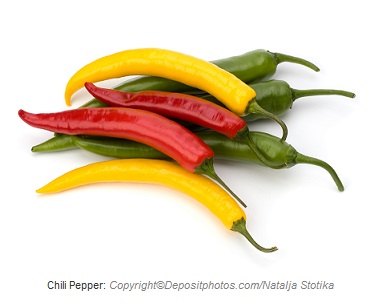Chili pepper is a vegetable from nightshade family and could be in red (red hot chili pepper),  green (green chili pepper) and yellow colors. The red hot chili pepper is also called “Cayenne pepper”. Chili pepper is edible fresh, dried, or in powdered form. One cup of chopped chilli pepper provides 15 grams of carbohydrates, 2 grams of fiber, and 2 grams of protein.
green (green chili pepper) and yellow colors. The red hot chili pepper is also called “Cayenne pepper”. Chili pepper is edible fresh, dried, or in powdered form. One cup of chopped chilli pepper provides 15 grams of carbohydrates, 2 grams of fiber, and 2 grams of protein.
Average calories: 68 per one cup.
|
Chilli Pepper: one cup, chopped |
|
|
Carbohydrate |
15 |
|
Fiber |
2 |
|
Protein |
2 |
|
Fat |
0 |
|
Calories |
68 |
Vitamins found in higher amounts: vitamins C, B6, A, K and B3.
Minerals found in higher amounts: potassium, copper, magnesium and iron.
Phytonutrients found in higher amounts and their health benefits: chili pepper has a small amount of beta-carotene and a substantial amount of capsaicin. Beta-carotene is a pro-vitamin A and an antioxidant vital for visual health.
Capsaicin is the active phytochemical in chili pepper. The attributed health benefits of capsaicin are as follows:
- Blocks the release of substance-P, a neurotransmitter that signals pain. Topical forms of capsaicin are used to relieve pain in arthritis, muscle ache, strains and sprains, fibromyalgia, and pain associated with nerve damage as in diabetic neuropathy, shingles, and phantom pain.
- Causes apoptosis (programmed cell death; cell suicide) in prostate and lung cancers.
- Inhibits the growth of cancer cells in leukemia.
- Reduces itching and inflammation in psoriasis.
- Helps adjust blood sugar level.
- Helps lower cholesterol and triglyceride levels.
- Prevents from platelet aggregation.
- Helps lose weight by increasing thermogenesis.
- Improves sexual erectile dysfunction by enhancing blood flow to the area.
Topical capsaicin is widely used by athletes to alleviate pain and discomfort from strains and sprains and to heat up as a pre-competition warm up. It is not banned in sports, but it is a prohibited substance in equestrian sports due to its analgesic effect.

